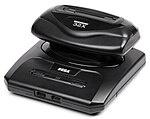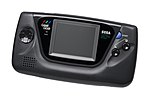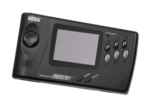世嘉官方標誌 世嘉 是電子遊戲開發 、發行 與硬件生產公司,其總部位於日本東京都 ,並在全球各地設有分公司。公司自1983年起製造家用遊戲機 和掌上遊戲機 ,所產主機橫跨第三世代 到第六世代 。它是由點唱機生產商日本娛樂物產和街機生產商Rosen Enterprises在1965年合併而成,並在此後20年間繼續製作街機遊戲。公司在1980年代街機業進入頹勢後,轉向家用遊戲軟硬件的開發銷售[1] SG-1000 ,於1983年在日本獨占發行。公司此後又在日本發行了多款改良機型,其中第3款主機Sega Mark III於1986年改名Master System 於全球銷售。公司從1988年開始推出Mega Drive 及其外設,1990年推出掌上遊戲機Game Gear ,1994年推出世嘉土星 ,1998年推出Dreamcast 。
世嘉曾為任天堂在遊戲機業的主要競爭者之一。世嘉某些早期主機在部分地區取得優勢,如歐洲的Master System。世嘉後期幾款主機被視為商業失敗,並因Dreamcast財務虧損在2001年內部重組。最終世嘉宣布退出主機製造業,轉型第三方遊戲開發商[2]
電子遊戲機 [ 編輯 ] 家用遊戲機 [ 編輯 ] 家用機外設 [ 編輯 ] 掌上遊戲機 [ 編輯 ] 第三方改版機型 [ 編輯 ] 世嘉遊戲機有經第三方授權或未授權修改。巴西Tectoy 修改並發行的Master System 3簡版支持射頻無線功能。該主機有專門面向女性玩家的Master System Girl版,其外殼為亮粉色。2006年在巴西推出的Master System 3合輯版內置120款遊戲[60] Coleco 於2006年在北美發行了掌上版Master System[61]
Mega Drive是世嘉最早有第三方版本的遊戲機:儘管Mega Drive比Master System晚面世3年,但改版卻出現的更早。JVS和日本世嘉合作,在1992年4月1日推出了Wondermega,這是Mega Drive和Mega-CD的一體機,音質更高。JVC後又將系統重新設計,於1994年9月以X'Eye名義在北美發行[62] 先鋒公司 製造的外設模塊Pioneer LaserActive 可遊玩Mega Drive和Mega-CD遊戲[63] Boombox 。幾間公司也模仿世嘉TeraDrive的設計,在個人電腦中集成了Mega Drive,如科威特和也門的MSX 機型AX-330和AX-990,以及在歐洲和澳洲銷售的Amstrad Mega PC [4] Majesco Entertainment 在Mega Drive停產後,於1998年北美發行廉價機種Genesis 3[64] [65]
Mega Drive在在巴西從未中斷生產,Tectoy於2007年12月5日發行了Mega Drive攜帶版,其中內置20款遊戲[66] 品 鍵吉他控制器[67] Sega Zone 有20款預裝Mega Drive遊戲[68] Radica Games 等公司推出了像系統控制器那樣的「即插即用」遊戲合輯[69]
參考文獻 [ 編輯 ]
^ Fahs, Travis. IGN Presents the History of SEGA . IGN . Ziff Davis . 2009-04-21 [2014-09-14 ] . (原始內容存檔 於2013-09-10). ^ Ahmed, Shahed. Sega announces drastic restructuring . GameSpot . 2001-01-31 [2009-09-20 ] . (原始內容 存檔於2010-09-01). ^ SG-1000 . Sega . [2014-02-14 ] . (原始內容存檔 於2014-07-16) (日語) . ^ 4.0 4.1 4.2 4.3 4.4 4.5 4.6 4.7 McFerran, Damien. Retroinspection: Master System. Retro Gamer (Imagine Publishing ): 48–53. ISSN 1742-3155 ^ Battelle, John. The Next Level: Sega's Plans for World Domination . Wired (Condé Nast ). December 1993 [2013-10-09 ] . (原始內容存檔 於2012-05-02). ^ SC-3000 . Sega . [2013-02-15 ] . (原始內容存檔 於2014-07-16) (日語) . ^ Kohler, Chris. Playing the SG-1000, Sega's First Game Machine . Wired . Condé Nast . 2009-10-02 [2009-10-05 ] . (原始內容存檔 於2014-01-01). ^ SC-3000H . Sega . [2013-02-15 ] . (原始內容存檔 於2014-02-22) (日語) . ^ Mark III . Sega . [2014-03-31 ] . (原始內容存檔 於2014-07-16) (日語) . ^ 10.0 10.1 10.2 10.3 Beuscher, David. Sega Master System - Overview . Allgame . All Media Network . [2014-03-31 ] . (原始內容存檔 於2014-09-14). ^ Cowen, Danny. Sega Master System Launch Schedule Reveals Unreleased Hot Rod, Phantasy Star II . GameSetWatch . UBM . 2011-09-14 [2014-06-22 ] . (原始內容存檔 於2014-09-14). ^ Sheff, David . Game Over 1st. Random House . 1993: 349 . ISBN 0-679-40469-4 ^ Slaven, Andy. Video Game Bible: 1985-2002 . Trafford Publishing . 2002-06-30: 225 . ISBN 1-553-69731-6In Europe, Sega continued production of the Master System until 1996. ^ Azevedo, Théo. Vinte anos depois, Master System e Mega Drive vendem 150 mil unidades por ano no Brasil . Universo Online . Grupo Folha . 2012-07-30 [2012-08-06 ] . (原始內容存檔 於2014-09-06) (葡萄牙語) . ^ 15.0 15.1 15.2 Retroinspection: Mega Drive. Retro Gamer (Imagine Publishing ). 2006, (27): 42–47. ISSN 1742-3155 ^ Kent, Steven L. The Ultimate History of Video Games: The Story Behind the Craze that Touched our Lives and Changed the World . Prima Publishing . 2001: 404 –405. ISBN 0-7615-3643-4 ^ Sega tops holiday, yearly sales projections; Sega Saturn installed base reaches 1.6 million in U.S., 7 million worldwide . Business Wire . Berkshire Hathaway . 1997-01-13 [2013-10-13 ] . (原始內容存檔 於2013-04-11). ^ Sega farms out Genesis . Consumer Electronics. Warren Communications News. 1998-03-02 [2012-07-09 ] . (原始內容存檔 於2012-07-09). ^ Sega Service Manual (Supplement): Genesis II/Mega Drive II. Sega . 1993. ^ Marriott, Scott Alan. Sega Genesis Nomad - Overview . Allgame . All Media Network . [2013-10-05 ] . (原始內容存檔 於2014-09-14). ^ Redsell, Adam. SEGA: A Soothsayer of the Game Industry . IGN . Ziff Davis . 2012-05-20 [2013-10-05 ] . (原始內容存檔 於2013-10-12). ^ Cartridge Console With 15 Sega Megadrive Games . Blaze Europe . [2010-07-16 ] . (原始內容 存檔於2014-08-04). ^ Kent, Steven L. The Ultimate History of Video Games: The Story Behind the Craze that Touched our Lives and Changed the World . Prima Publishing . 2001: 447 . ISBN 0-7615-3643-4 ^ Clements, Matthew T.; Ohashi, Hiroshi. Indirect Network Effects and the Product Cycle: Video Games in the U.S., 1994–2002 (PDF) . NET Institute: 12, 24. October 2004 [2011-09-21 ] . (原始內容存檔 (PDF) 於2014-09-14). ^ ファミ通エクスプレス "ピコ"といっても紅茶じゃないぞッ! セガが幼児向けコンピューターを発売 . Famicom Tsūshin (ASCII Media Works ). 1993-06-11, 8 (24): 11 (日語) . ^ 26.0 26.1 Sega captures dollar share of videogame market -- again; diverse product strategy yields market growth; Sega charts path for 1996. . Business Wire . Berkshire Hathaway . 1996-01-10 [2011-09-29 ] . (原始內容存檔 於2014-05-02). ^ 27.0 27.1 TOSEC: Sega Pico . Internet Archive . 2012-04-13 [2014-06-22 ] . (原始內容存檔 於2014-01-23). ^ 28.0 28.1 28.2 28.3 食育、安全などの“五育”を取り入れ、エデュテイメント事業を推進「遊びながら学ぶ」が進化する『Advanced PICO BeenaTM』(アドバンスピコ ビーナTM)8月発売 (PDF) . Sega . 2005-04-05 [2014-06-03 ] . (原始內容 (PDF) 存檔於2007-09-28) (日語) . ^ Edison, N.J.-Based Firm Signs Video Game Distribution Deal with Sega. . Home News Tribune – 透過HighBeam Research Gannett Company . 1999-08-06 [2011-09-29 ] . (原始內容 存檔於2014-06-29). ^ 30.0 30.1 Beuscher, David. Sega Pico - Overview . Allgame . All Media Network . [2014-06-03 ] . (原始內容存檔 於2014-09-14). ^ Sega Toys Business Strategy . Sega . 2005 [2016-01-08 ] . (原始內容 存檔於2005-12-16). ^ Sega Saturn . Sega . [2014-03-03 ] . (原始內容存檔 於2014-07-16) (日語) . ^ Cifaldi, Frank. This Day in History: Sega Announces Surprise Saturn Launch . 1UP.com . Ziff Davis . 2010-05-11 [2014-05-04 ] . (原始內容 存檔於2014-09-14). ^ 34.0 34.1 McFerran, Damien. Retroinspection: Sega Saturn. Retro Gamer (Imagine Publishing ): 44–49. ISSN 1742-3155 ^ 35.0 35.1 Kent, Steven L. The Ultimate History of Video Games: The Story Behind the Craze that Touched our Lives and Changed the World . Prima Publishing . 2001: 558 –559. ISBN 0-7615-3643-4 ^ Moriarty, Colin. Sega Pluto: The console that never was? . IGN . Ziff Davis . 2013-04-18 [2014-03-03 ] . (原始內容存檔 於2014-03-20). ^ Lefton, Terry. Looking for a Sonic Boom. Brandweek (Nielsen Business Media ). 1998, (39.9): 26–29. ISSN 1064-4318 ^ Hernandez, Patricia. Happy 15th Birthday, Dreamcast! . Kotaku . Gawker Media . 2013-11-28 [2014-06-13 ] . (原始內容存檔 於2014-03-29). ^ 39.0 39.1 Dreamcast beats Playstation record . BBC News . 1999-11-24 [2008-08-19 ] . (原始內容存檔 於2013-10-16). ^ Sega Scraps the Dreamcast . BBC News . 2001-02-24 [2008-08-22 ] . (原始內容存檔 於2014-08-13). ^ Sega Sports NFL 2K1 Outsells the Competition on Its Debut; First Ever Online Console Game NFL 2K1 Becomes Number One Football Game This Fall . Business Wire (Berkshire Hathaway ). 2000-11-28 [2008-08-19 ] . (原始內容存檔 於2014-09-14). ^ Wilde, Tyler. A tribute to the Dreamcast VMU . GamesRadar . Future . 2009-09-08 [2014-06-13 ] . (原始內容存檔 於2014-09-14). ^ Sega warns of losses . BBC News . 2000-02-28 [2014-06-13 ] . (原始內容存檔 於2013-11-11). ^ 『BeenaLite(ビーナライト)』7月17日新発売 (PDF) . Sega . 2008-06-18 [2014-10-23 ] . (原始內容存檔 (PDF) 於2014-08-16) (日語) . ^ Mega-CD . Sega . [2014-03-29 ] . (原始內容存檔 於2014-07-16) (日語) . ^ Kent, Steven L. The War. The Ultimate History of Video Games: The Story Behind the Craze that Touched our Lives and Changed the World . Prima Publishing . 2001. ISBN 0-7615-3643-4 ^ 47.0 47.1 Birch, Aaron. Next Level Gaming: Sega Mega-CD. Retro Gamer (Live Publishing). 2005, (17): 36–42. ISSN 1742-3155 ^ Beuscher, David. Sega CD - Overview . Allgame . All Media Network . [2013-06-27 ] . (原始內容 存檔於2014-09-14). ^ Mega-CD 2 . Sega . [2014-03-29 ] . (原始內容存檔 於2014-05-30) (日語) . ^ Marriott, Scott Alan. Sega Genesis CDX - Overview . Allgame . All Media Network . [2013-06-27 ] . (原始內容 存檔於2014-09-14). ^ Videospiel-Algebra. Cybermedia Verlagsgesellschaft. May 1995 (德語) . ^ Super 32X . Sega . [2014-02-23 ] . (原始內容存檔 於2014-07-16). ^ 53.0 53.1 Kent, Steven L. The "Next" Generation (Part 1). The Ultimate History of Video Games: The Story Behind the Craze that Touched our Lives and Changed the World . Prima Publishing . 2001. ISBN 0-7615-3643-4 ^ McFerran, Damien. Retroinspection: Sega 32X. Retro Gamer (Imagine Publishing ): 44–49. ISSN 1742-3155 ^ 55.0 55.1 55.2 55.3 Beuscher, David. Sega Genesis 32X — Overview . Allgame . All Media Network . [2013-06-07 ] . (原始內容 存檔於2014-09-14). ^ Forster, Winnie. The Encyclopedia of Game.Machines: Consoles, Handhelds, and Home Computers 1972-2005. Magdalena Gniatczynska. 2005: 139. ISBN 3-0001-5359-4 ^ Retroinspection: Sega Game Gear. Retro Gamer (Imagine Publishing ). 2009, (41): 78–85. ISSN 1742-3155 ^ 58.0 58.1 Sega Game Gear. Retro Gamer (Live Publishing). 2005, (17): 26–35. ISSN 1742-3155 ^ 59.0 59.1 59.2 Beuscher, David. Sega Game Gear - Overview . Allgame . All Media Network . [2013-07-08 ] . (原始內容 存檔於2014-09-14). ^ Szczepaniak, John. Company Profile: Tec Toy. Retro Gamer (Imagine Publishing ). 2006, (30): 50–53. ISSN 1742-3155 ^ Ransom-Wiley, James. Sega-filled handheld . Joystiq . AOL . 2006-10-26 [2010-04-22 ] . (原始內容存檔 於2014-04-07). ^ Marriott, Scott Alan. JVC X'Eye - Overview . Allgame . All Media Network . [2013-07-02 ] . (原始內容存檔 於2014-09-14). ^ Marriott, Scott Alan. Pioneer LaserActive - Overview . Allgame . All Media Network . [2013-07-02 ] . (原始內容 存檔於2014-09-14). ^ Sheffield, Brandon. A Casual Rebirth: The Remaking of Majesco . Gamasutra . UBM . 2009-08-10 [2013-10-09 ] . (原始內容存檔 於2014-05-10). ^ Edison, N.J.-Based Firm Signs Video Game Distribution Deal with Sega. . Home News Tribune . Gannett Company . 1999-08-06 [2011-09-29 ] . (原始內容 存檔於2014-06-29) –透過HighBeam Research ^ Melanson, Donald. Brazil's TecToy cranks out Mega Drive portable handheld . Engadget . AOL . 2007-11-13 [2007-01-23 ] . (原始內容存檔 於2013-10-12). ^ Mega Drive Guitar Idol - 87 jogos . Tectoy . [2010-07-16 ] . (原始內容 存檔於2009-08-26) (葡萄牙語) . ^ Innex Launches Products Containing Licensed Sega Genesis Titles In Time For Q4 Holiday Season . Innex. September 2009 [2011-04-25 ] . (原始內容 存檔於2014-07-22). ^ Horowitz, Ken. Hands-On: Arcade Legends (Plug-'n-Play) . Sega-16. 2004-09-16 [2013-11-17 ] . (原始內容存檔 於2014-07-02).
開發部門
消費者研發部
街機研發部
線上研發部 行動軟體研發部
街機 家用遊戲機 可攜式裝置 雙系統 線上服務 周邊配件 相關












 . Gannett Company. 1999-08-06 [2011-09-29]. (原始內容存檔於2014-06-29).
. Gannett Company. 1999-08-06 [2011-09-29]. (原始內容存檔於2014-06-29).
 .
.

